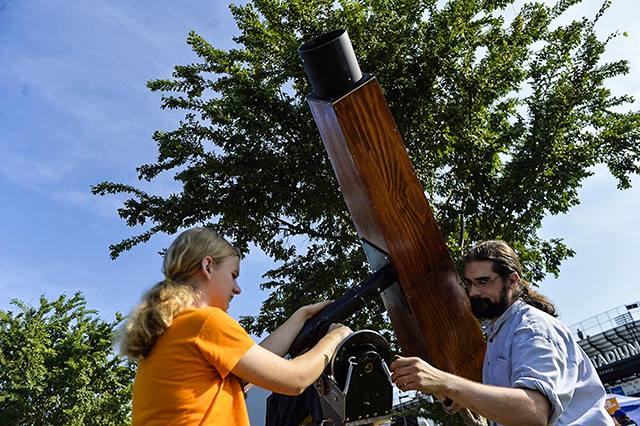Stunning Solar Eclipse Photos From The 'Eclipse Crossroads Of America' In Illinois
By aaroncynic in News on Aug 21, 2017 8:55PM
Thousands filled the football stadium at Southern Illinois University in Carbondale, Illinois for the chance to catch the full totality of the 2017 solar eclipse.
Amateur and not-so-amateur photographers, astronomers, and other enthusiasts began to arrive long before sunrise Monday morning. The university, which played host to some 14,000 people at its Saluki Stadium according to officials, had a full day of events planned surrounding the event, including the launch of three weather balloons equipped with sensors and cameras.
“There has never been a time when the spotlight has shined so brightly on Carbondale, so we see this as an amazing opportunity for us, and [Southern Illinois University], to introduce ourselves to the rest of the country and the world,” city manager Gary Williams told Live Science on Sunday. The city has been dubbed the “eclipse crossroads of America,” because it will also play host to another solar eclipse in 2024.
The first contact moment came around 11:50 a.m., and with proper eclipse glasses or solar filters, a small sliver of the moon crawling across the sun became visible. But as totality drew closer, so did one large cloud. As what appeared like dusk began to quickly fall on the hushed crowd near totality, cheers went up as the clouds parted for the last few seconds of totality—the moment when an eclipse can be viewed without any special equipment or eye protection.
“It felt like the crowd was sending the energy up to move that cloud along and then it did like a miracle,” Julie Dodge, who traveled to Carbondale from Peoria, told Chicagoist. “I feel so fulfilled, because it was down to that last wire. That cloud was going by and boom, we got to see it.”
Dodge said that she initially planned to go somewhere more remote, but ultimately decided on Carbondale because of the crowds.
Bc 2017 isn't already dramatic enough, the cloud covering totality in Carbondale parted with about 20 seconds to go #SolarEclipse2017 pic.twitter.com/Qb07gHcX1Z
— Aaron Cynic (@aaroncynic) August 21, 2017
“Initially I wanted to go watch it out somewhere in the wild where it’s just nice, quiet and secluded, but there’s something about having the crowd—being part of an event—that was really exciting,” she said. "Hearing the crowd gave me goosebumps because everyone was experiencing everything at the same time.”

Chris Olsen, a photographer from Aurora, Illinois, readies his heliograph to photograph the solar eclipse of 2017 in Carbondale, Illinois. Photo by Tyler LaRiviere/Chicagoist.
Chris Olsen, a wet plate photographer from Aurora, Illinois, built a replica of a heliograph, first built in 1857 to photograph the sun, and later used by Warren De La Rue to photograph a solar eclipse in Spain in 1862. He said he began working on the project more than a year ago.
“I’m looking at and I’m like ‘there’s an eclipse coming up in a year and a half, I can do that. I crowdfunded the majority of this and said ‘I can do my own solar expedition,” said Olsen.
Amy Majuka, from suburban Darrien Illinois attended with her parents, who said they had been planning for the event for months. Majuka’s father described the first time he saw an eclipse as a child. “I was about 8 or 10 years old in the Philippines,” he said. “It heightened the anticipation. It’s a lot different now—we used a pinhole on cardboard and looked at projections. Nowadays we’ve got solar filters.”